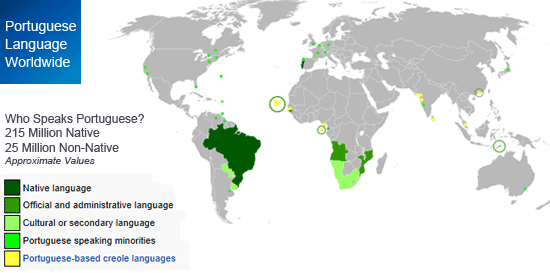Today the most widely used Portuguese dialects are European Portuguese and Brazilian Portuguese. Continental Portugal, the motherland of all Portuguese colonies, is where the language originated and then it spread to exotic locations around the world.
Brazil now holds the linguistic power, not just because it’s the fifth-largest country in terms of land mass and population but also because of its economy. In fact, Brazil has proved to be an upcoming power in the world of business and commerce which is why so much of the Portuguese language is moving to the Brazilian Portuguese dialect. It’s also why there’s been a consistent effort to unify the language through orthographical changes in order to create a standardized language for business use.
[notification style=”tip” font_size=”12px”] Orthography is the standardized system of rules that dictate how a language is to be written. The orthography of a language includes spelling, hyphenation, capitalization, word breaks, emphasis, accents and punctuation. [/notification]
While there are stark differences between the orthography of Portugal and Brazil, throughout the 20th and 21st centuries there have been many attempts to form a common spelling to be used around the world, especially for business purposes.
So, this is the most frequent question we’re faced with: which dialect should a company use for translation of business documents and marketing materials? Is it possible to use the same translation text for Brazil and Portugal?
The answer is no. Brazilian and European Portuguese are very different – from spelling to terminology. In most cases, it’s unacceptable to use European Portuguese with a Brazilian audience and vice-versa.
However, here’s the good news:
Brazilian Portuguese is quickly becoming the standard dialect for all Portuguese used.
It’s not only that Brazil has a population that’s eighteen times larger than Portugal’s, but also the fact that Brazil’s economy is the driving force of why so much of the Portuguese is moving to the Brazilian dialect. In addition, Brazil has accepted more US technical terms into the language than European Portuguese. For example, words such as software, site, and mouse are used in English in Brazil while in Portugal these terms are translated as: logicial, sitio and rato.
The Orthographic Agreements
Spelling or orthography are different in Brazil and Portugal. However, in January 2009 a spelling reform was introduced in Brazil which was also implemented in Portugal in mid 2011 whose purpose was to make Portuguese a uniform language globally. In other words, this reform was meant to make it easier to run searches and understand Portuguese content online no matter which Portuguese dialect it was written in. The reform was not successful as it only changed about 0.5% of Brazilian Portuguese words and about 1.5% of European Portuguese words.
In January 2012, another spelling reform was rolled out, the result being the standardization of spellings to mirror the Brazilian form. This has also caused a lot of frustration and confusion. These ongoing changes will affect anyone translating Portuguese, those in business as well as professional translators.
Are two different versions of Portuguese a requirement?
While linguistically the two dialects are mutually intelligible, when doing business abroad you need to consider cultural and linguistic requirements of the target market. For instance, when translating Portuguese for the US market, Brazilian Portuguese is generally the preferred version.
In conclusion, with Brazilian Portuguese becoming the standard dialect for Portuguese, you might want to focus on translating your websites, manuals, marketing materials, etc, into Brazilian Portuguese first.
If you are using SYSTRAN software, it includes both dialects, just be sure to go into the options and specify which dialect. Find out more about our Portuguese translation software that can help you translate both European Portuguese and Brazilian Portuguese while saving you thousands of dollars in translation costs.



